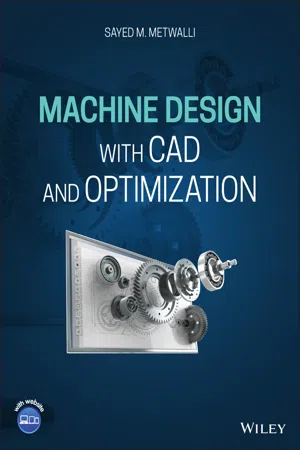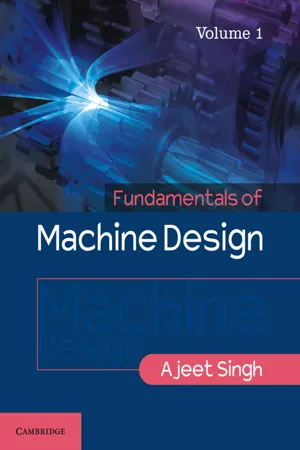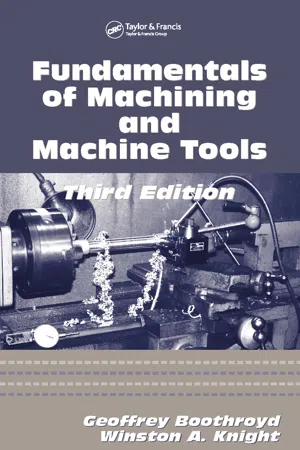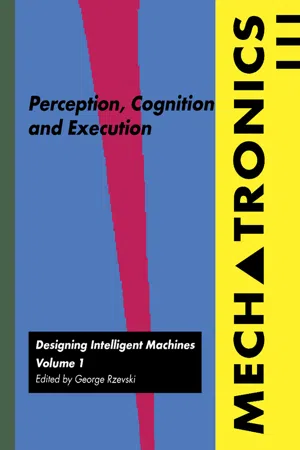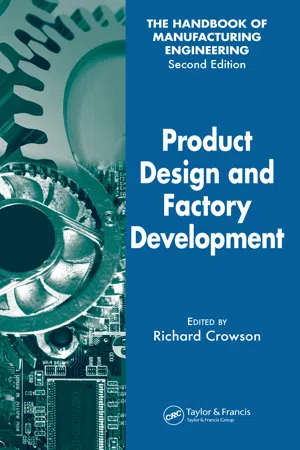Technology & Engineering
Machine Design
Machine design involves the process of creating new machines or improving existing ones to meet specific requirements. It encompasses various engineering disciplines such as mechanical, electrical, and industrial engineering to design machines that are efficient, reliable, and safe. This process involves conceptualizing, modeling, prototyping, and testing to ensure that the machine meets its intended purpose.
Written by Perlego with AI-assistance
Related key terms
1 of 5
6 Key excerpts on "Machine Design"
- eBook - ePub
- Sayed M. Metwalli(Author)
- 2021(Publication Date)
- Wiley(Publisher)
1 Introduction to DesignA design is understood to be an object that fulfils a function or performs a job. Different designs can be of objects other than machines. In engineering, design can be associated with different fields of engineering such as bridges and highways in civil engineering; ship design in marine engineering; electric motors, computers, and communication equipment in electrical and electronic engineering; and so on. In mechanical engineering, Machine Design, engines, turbines, pumps, and heating or cooling systems are some of the main areas of mechanical design. Machine Design, however, can be defined as the process of getting the design of a machine and its components. The design of a machine can be understood as the machine form and construction as an object that is made to perform the function of the machine. The machine is generally a device composed of moving parts to perform a function that consumes or transforms power or energy. A motorcycle or a vehicle is a machine that transforms energy into moving a person or persons from one point to the other and consumes energy generated by the engine or the motor to do so. The consumed energy is spent mainly in overcoming air and ground resistances, acceleration and deceleration, and potential energy for different elevations up or down if no regenerative mean is present. Figure 1.1 shows an example of a trans-mixer design that transports concrete from a mixing station to a construction site. The truck carrying the mixer consumes power in continuous rotation and in transporting the concrete charge over the roads to the construction site. A separate power is usually used to keep the mixer drum continuously rotating during transit, accelerations and decelerations, and pouring the concrete into the desired location (Badawy et al. 1994 ). The machine tool is another design of a complex device consuming energy in producing components by machining or other manufacturing processes. A mechanism - eBook - PDF
- Ajeet Singh(Author)
- 2017(Publication Date)
- Cambridge University Press(Publisher)
Outcomes Know stages in design, right from conception to final product after production Factors to be considered while designing Various types of designs Know about fundamental and derived units used in engineering design Importance of standardization, its advantages and use in design International standards and designation of standard mechanical components Preferred numbers, their advantages, and use of various series for selection 1.1 Introduction Machine is a device, which facilitates the working for which it is designed. For example, sewing machine facilitates stitching, automobiles facilitate travelling. Machines could be of many types, as given below, but here the scope is limited to mechanical machines only. A machine, unless specified, is a Mechanical machine. Input to this machine could be mechanical, electric, or any other type of power. • Electric machine, which uses electric energy; • Pneumatic machine, which uses compressed air; and • Hydraulic machine, which uses any fluid like water (turbines) or oil, etc. C H A P T E R 1 Introduction to Machine Design Fundamentals of Machine Design, Volume I 2 A machine comprises of many machine elements, like shafts to accommodate the machine elements like pulleys, gears, etc., to transmit power; bearings to support the shaft; frame to support and keep all the parts in the required position. Machine Design is a subject, which deals with the design of machine elements and other aspects like shape, colour, etc. The design is mainly from the strength point of view. The size is calculated so that under the given conditions of loading, the part will not break or deform beyond accepted allowable limit. 1.2 Stages in Design The design of a machine which is seen today is not the original design. Rather, it is being modified every year. For example, models of cars are changing every year. The design is modified as new materials are developed, which could be stronger than the existing ones. - Winston A. Knight, Geoffrey Boothroyd(Authors)
- 2019(Publication Date)
- CRC Press(Publisher)
439 13 Design for Machining 13.1 INTRODUCTION Many techniques are available to reduce manufacturing costs and increase man-ufacturing productivity. These measures include using: 1. Improved materials, tools, and processes 2. More effective organization and factory layout, materials handling, and assembly techniques 3. Automation, wherever it contributes to greater efficiency Unfortunately, designers often consider that their job is to design the product for performance, appearance, and possibly reliability, and that it is the manufac-turing engineer’s job to produce whatever has been designed. There is often a natural reluctance to change a proven design for the sake of a reduction in manufacturing cost, and although designers generally assert that they take man-ufacturing problems into account whenever possible, the fact is that as a subject, design for manufacture is hardly recognized compared with design for perfor-mance. Sometimes design for manufacture is mentioned briefly in textbooks on manufacturing, but only rarely is it mentioned in textbooks on design. Many companies ensure that their designers obtain some manufacturing expe-rience, and many university engineering programs include courses in manufac-turing. All this is beneficial, but design for manufacture is one of those subjects a person is expected to assimilate through experience rather than learn from a textbook or instructor. This chapter explains one important aspect of this subject: design for machining. For obvious reasons machining is a wasteful process, and many engineers feel that the main concern should be to design components that do not require machining. Since 80 to 90% of manufacturing machines are designed to machine metal, the view that machining should be avoided must be considered impracti-cable for the immediate future.- eBook - PDF
- Zhuming Bi, Xiaoqin Wang(Authors)
- 2020(Publication Date)
- Wiley-ASME Press Series(Publisher)
Figure 6.2 Growing complexity of design of modern machines. Computer Aided Machine Design 221 Figure 6.3 Example of complexity growth of Machine Design. (a) Traditional machines in well-structured environment with less challenges. (b) Complex machines in open and dynamic environments with more and more challenges. the trend of robotic systems as an example of complexity growth of Machine Designs. Traditionally, industrial manipulators (Figure 6.3a) have a fixed base and operate in a well-structured environment; these manipulators are not designed to deal with unpredicted uncertainties and changes in environments. With the emerging needs of the capabilities for the collaboration and interaction with human beings, robots must be designed to be able to sense changes, detect events, and respond to objects in an open ill-structured environment safely. The complexity of robotic design has been increased greatly in terms of the degrees of motions, the number of sensors and actuators, and time-dependent characteristics. Machine Design is an essential step to build a machine since it determines how a machine should be structured, assembled, and functioned to meet the design requirements by users. Similar to the design of other products, basic elements in a Machine Design are conceptions, inventions, visualizations, calculations, refinements, and specifications of details that deter- mine the machine structure. The design process is iterative and Figure 6.4 shows some critical steps. The axiomatic design theory (ADT) can be used as a guide for the design process. Firstly, the product needs in the customers’ domain are analysed. Secondly, the identified needs are technically interpreted as the functional requirements (FRs) of prod- ucts. Thirdly, design variables (DVs) for specified FRs are explored to define a design space of technical solutions. - eBook - PDF
Mechatronics: Designing Intelligent Machines Volume 1
Perception, Cognition and Execution
- George Rzevski(Author)
- 2014(Publication Date)
- Newnes(Publisher)
A further important step has been the emergence of concurrent engineering, where the manufacturing engineering is carried out in parallel with the design activity, instead of in series, after the design work is complete. The drive towards concurrent engineering has come from the need to dramatically reduce product development timescales and the absolute need to design within strict cost targets. The latter can only be achieved when the manufacturing methods and processes are planned in conjunction with the design process. Indeed, in the best examples of this practice, material is being machined before the design is complete, and before drawings are available in even rudimentary form. This is possible by use of advanced C ADC AM (computer-aided design/manufacture) techniques. Concur-rent engineering is a most important facet of the modern design process, in mechatronic product design as elsewhere. Consequently, when we look at the modern method of design, we see not only the specialist technology areas within design, but manufacturing engineering as well. This is shown in diagram form in Figure 10.4. An easy way to differentiate between manufacturing engineering and the older discipline of production engineering is to remember that manufacturing engi-neering covers the design of the manufacturing process, so only has to be done once for a particular design. Production engineering is concerned with the actual making of the designed product in whatever quantities the sales or market demands. This approach quickly demonstrates that manufacturing engineering is part of the design process, whereas production engineering is not. This scenario illustrates the need for team work and communications. Note that this example started with mechanical engineering, which in most mechatronic products will still be the lead technology. - eBook - PDF
- Richard Crowson(Author)
- 2005(Publication Date)
- CRC Press(Publisher)
Experience tells us that it is necessary to involve production process expertise early in the design and development phases of all new programs. The best product design for manufacturing will be one that: Considers all elements of the fabrication, subassembly, and assembly operations leading to a completed product Is able to accept the manufacturing process tolerances Uses straightforward, understandable manufacturing processes that lead to first-time quality during production start-up Can be built with automated process equipment using programmable process controllers (when appropriate) Does not require separate inspection operations, but empowers the operator with the responsibility for his or her work Allows statistical process control (SPC) to monitor the production operations and permits operator adjustment of the process to ensure 100% quality every time 2 58 Product Design and Factory Development Contributes to a shorter manufacturing cycle with minimum work in process Can be built for the lowest cost 2.1 DESIGN FOR MACHINING 2.1.0 Introduction to Design for Machining An early comment on designing parts for machining should be to question the necessity of machining the part. With the options available for other processes to consider, this is no simple task. Leo Alting, in Manufacturing Engineering Processes (1982), dis-cusses “mass conserving” processes such as rolling, extrusion, forming, swaging, cold heading, and the like. The idea is that a piece of metal may be modified to produce a finished part, without cutting chips. Many times, a part using “mass reducing” tech-niques, such as cutting chips on some type of machining center, may retain only 20% of the original metal, while 80% winds up as chips or scrap.
Index pages curate the most relevant extracts from our library of academic textbooks. They’ve been created using an in-house natural language model (NLM), each adding context and meaning to key research topics.
